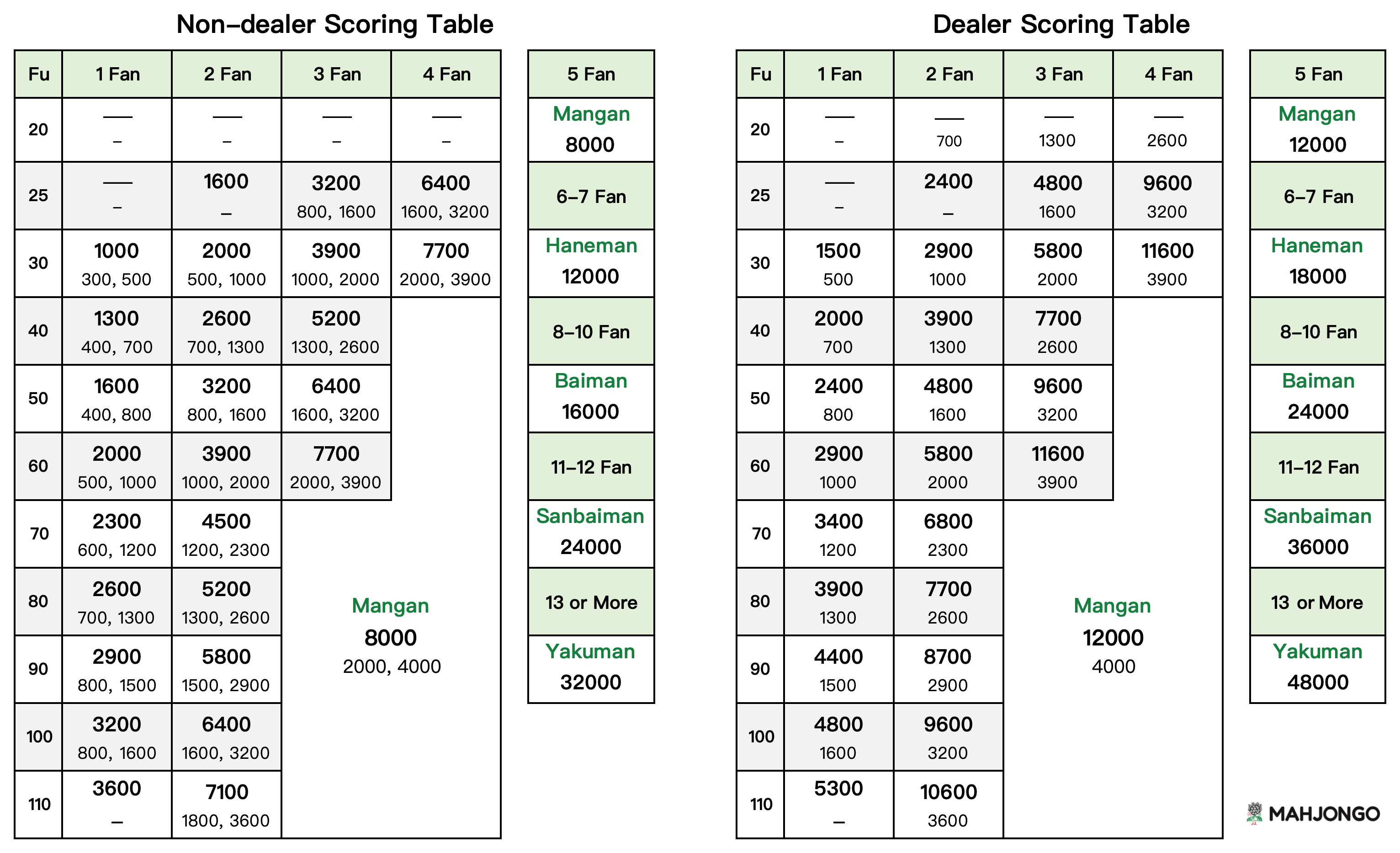Riichi Mahjong
Japanese Mahjong, also known as Riichi Mahjong, focuses on strategy, logic, and precise calculations. It’s popular in Japan and worldwide. What makes it unique is its scoring system, with high-value hands like Yakuman, detailed point calculations, and special rules like Riichi and Dora, making the game both challenging and fun. ⛩️
Riichi Mahjong Tiles
 Japanese Mahjong tiles include three suit types: Pin, Sou, and Man, as well as Winds and Dragons tiles: East, South, West, North, Red Dragon, Green Dragon, and White Dragon. A full set has 136 tiles, excluding the "Flowers" and "Seasons" tiles from Chinese Mahjong.
Japanese Mahjong tiles include three suit types: Pin, Sou, and Man, as well as Winds and Dragons tiles: East, South, West, North, Red Dragon, Green Dragon, and White Dragon. A full set has 136 tiles, excluding the "Flowers" and "Seasons" tiles from Chinese Mahjong.
One special tile is the Red Dora, which includes the 5 Pin, 5 Sou, and 5 Man. Each Red Dora adds 1 extra Fan to the score. Players start with 13 tiles and aim to form specific combinations by drawing and discarding tiles to win. 🀄️
Riichi Mahjong Rules
The basic rules of Japanese Mahjong are similar to Chinese Mahjong, with the goal of completing a valid "winning hand." However, Japanese Mahjong focuses on Yaku, which are specific scoring conditions or patterns needed to win. Players must fulfill at least one Yaku to declare a win. In addition to Yaku, there are several unique rules, including:
- Riichi: Once the conditions are met, players can declare Riichi, which increases the chances of winning and adds to the score.
- Dora: Dora are bonus tiles randomly revealed during the game, which increase the score.
- Draw: If no player wins during a round, or if certain special conditions occur, the round ends in a draw.
We have prepared a beginner's guide to Japanese Mahjong: Mahjong Tiles, Yaku, Yakuhai, All Simples, Riichi, Furiten, Dora. 🎲
Yaku List
Yaku is specific scoring conditions or patterns needed to win. in Japanese Mahjong, and understanding Yaku is crucial for winning in the game.
- 1 Han: Riichi • Ippatus • Fully Concealed Hands • Pinfu • All Simples • Pure Double Sequence • Yakuhai • After a Kan • Robbing a Kan • Under the Sea • Under the River
- 2 Han: Double Riichi • Triplet Triplets • Three Quads • All Triplets • Three Concealed Triplets • Little Three dragons • All Terminals and Honours • Seven Pairs • Half Outside Hand • Pure Straight • Mixed Triple Sequence
- 3 Han: Twice Pure Double Sequence • Fully Outside Hand • Half Flush
- 6 Han: Full Flush
- Yakuman: Blessing of Heaven • Blessing of Earth • Big Three Dragons • Four Little Winds • Four Concealed Triplets • Four Quads • All Honors • All Green • All Terminals • Thirteen Orphans • Nine Gates • Single-wait Four Concealed Triplets • Thirteen-wait Thirteen Orphans • True Nine Gates • Four Big Winds
- Mangan: Nagashi Mangan
Japanese Mahjong Scoring Calculation
Fu Calculation
Fu is an important part of Mahjong scoring, reflecting the complexity of the hand. It is calculated based on various factors and then rounded to the nearest multiple of 10 for the final score.

Basic Points
The calculation formula for basic points is: Basic Points = Fu × 2^(Han + 2).
When the basic points exceed 2000, the following special rules apply:
- Mangan: 5 Han, or 4 Han with basic points greater than 2000. The basic points are fixed at 2000.
- Haneman: 6–7 Han, the basic points are 3000.
- Baiman: 8–10 Han, the basic points are 4000.
- Sanbaiman: 11–12 Han, the basic points are 6000.
- Yakuman: 13 Han and above, the basic points are 8000.
When players are responsible for paying points, the points are calculated as follows (rounded up to the nearest 100 if below 100):
- Non-dealer's self-drawn win: The dealer pays 2 times the basic points, while the other two non-dealers each pay the basic points.
- Non-dealer's win by discard: The player who discarded the tile pays 4 times the basic points.
- Dealer's self-drawn win: The other three players each pay 2 times the basic points.
- Dealer's win by discard: The player who discarded the tile pays 6 times the basic points.
Scoring Quick Reference Table
Calculating basic points can be complex, so a quick reference table is used for easy lookup. Players just need to know the Fu and Fan of their winning hand to find the score, saving time on detailed calculations.

Non-Dealer Scoring Table: In each row, the first line shows the points collected for winning by discarding a tile, and the second line shows the points collected for self-drawn win from each non-dealer and the dealer.
Dealer Scoring Table: In each row, the first line shows the points collected for winning by discarding a tile, and the second line shows the points collected for self-drawn win from each non-dealer.
Japanese Mahjong Strategy Tips
A good Riichi Mahjong player typically possesses the following strategic and tactical skills:
- Observe Dora: Dora are important tools for increasing your score. Effectively using Dora or limiting your opponents' access to Dora is crucial.
- Master the Rhythm: Adjust your play style based on the situation—choose offense or defense depending on the risk. For example, play defensively when the game is risky to avoid giving your opponents easy wins.
- Choose the Right Yaku: Learn the common Yaku (scoring patterns) and use them flexibly. This will not only increase your score but also speed up the process of winning.
- Deduce Opponents’ Hands: By observing your opponents' discards and patterns, you can infer their hand and strategy, allowing you to adjust your own actions accordingly.
- Strategic Riichi: While Riichi offers a chance for a higher score, it also exposes your hand. Be sure to use it at the right moment when the risk is worth it.
Riichi Mahjong Frequently Asked Questions (FAQ)
What is Riichi Mahjong?
Riichi Mahjong is the Japanese variant of Mahjong that focuses on strategy, precise scoring, and unique rules like Riichi (a declaration of a ready hand). It requires players to fulfill at least one Yaku (scoring pattern) to declare a winning hand, making it more dynamic and challenging compared to some other Mahjong variants.
How is it different from standard Chinese Mahjong?
While both games involve drawing and discarding tiles to form sets, Riichi Mahjong introduces:
- Riichi (placing a bet of 1,000 points when one tile away from winning)
- Dora (bonus indicator tiles that increase your score)
- More stringent requirements (e.g., needing at least one Yaku)
These elements add layers of complexity to hand-building and defense.
Why do I need at least one Yaku to win in Riichi Mahjong?
In Riichi Mahjong, you can’t simply form any winning pattern; you must have at least one Yaku. This rule ensures every win is strategically planned. It also makes identifying and targeting specific Yaku an integral part of the game.
What are Dora tiles, and how do they affect scoring?
Dora tiles are special bonus tiles that boost your final score. One example is the Red Dora (the red 5 of each suit), each granting +1 Han (fan) to your hand. Strategically using Dora—or preventing opponents from using them—is crucial to securing high-value wins.
What is Riichi, and when should I declare it?
When your hand is concealed and one tile away from winning, you can declare Riichi by placing a 1,000-point bet on the table. This declaration:
- Locks your hand so you can’t change your waits.
- Increases the hand’s potential score if you do win.
Balancing risk and reward is key when deciding to declare Riichi.
How does Furiten work?
Furiten is a penalty state in which you cannot win on another player’s discard if you have already passed on that winning tile or if you’ve discarded a tile that would complete your hand. This prevents “fishing” for the same tile multiple times and adds a layer of defensive play.
How can I calculate my score in Riichi Mahjong?
Riichi Mahjong scoring combines two main factors:
- Han (based on the Yaku in your hand)
- Fu (based on hand structure and type of wait)
For a quick and accurate calculation, you can use the Riichi Mahjong Score Calculator on MahJongo.
Does MahJongo offer resources for beginners?
Yes! Mahjongo provides a variety of beginner-friendly guides and tools, such as:
- Mahjong Tiles: Learn about the tile sets and their unique features.
- Riichi Yaku List: Understand the different Yaku and how they affect scoring.
- Riichi Generator: Practice building different hands.
Are there any differences when playing Riichi Mahjong online at MahJongo?
Mahjongo’s online platform is designed to mirror the traditional Riichi rules while making it more accessible. You’ll enjoy:
- A clear, user-friendly interface.
- Practice modes to learn or refine your strategy.
- Real-time opponents or AI for flexible gameplay.
Where can I go for more information and community support?
- Mahjongo: The Learning Center provide in-depth articles, tips, and tutorials.
- Online Communities: Join MahJongo feedback or Discord servers to connect with fellow players, ask questions, and share strategies.
Others
Language: Japanese • Simplified Chinese • Traditional Chinese
Tool: Riichi Mahjong Tile Generator • Riichi Mahjong Score Calculator
Special Thanks
dichohecho, D.Koehnen, Hilanderiam, Ken...
Thank you for your feedback on Riichi Mahjong. Our goal is to create the best Mahjong game site on the Internet, and we can‘t do it without your feedback. 🥳
LEARN
TOOLS



